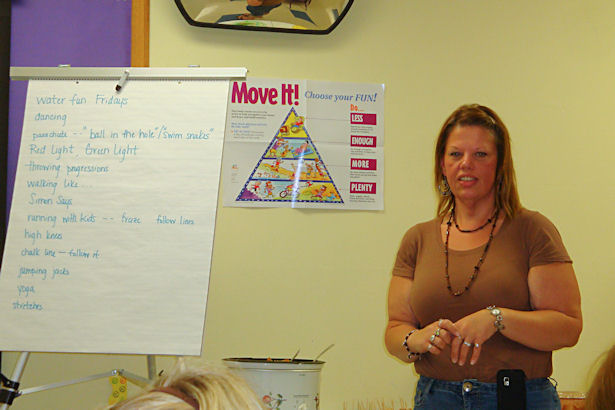“Credentials and References” follow the history of my child care program.
I arranged my Credentials in outline form because it was easy to scan yet let me go into detail. Since my references took up less than a half-page of space and fit nicely at the end of my credentials I decided to put them together instead of putting the references on a separate page.
Next is a description of my Daily Routine. I’ve posted my daily routine for years but had never thought to describe the “what” and “why” of each part of our day. I also changed my wording from “schedule” which implies a close connection to the clock to “routine” which more closely fits my philosophy, which is to do the same things in the same order – but not necessarily at the same exact time – every day.
After discussing daily routines with other family child care providers I was interested to see that many of them had developed the same basic routine as I have, especially those that have only worked in a family chid care setting. On the other hand, many providers who came to family child care from a group setting seem to have a more detailed and busy daily routine. I wonder if that’s the case in general, or just among the small group of providers I know.
Daily Routine
I believe in allowing children to finish one activity before moving to the next, and that attending to children’s needs is more important than following a clock. Our daily routine offers a balance of free play and teacher-directed activities, as well as time to be active and time to relax. Although our routine is flexible, events occur in the same order every day, which gives the children a feeling of security.
Program Opens
Amy & Kids Co. opens promptly at 7:00 AM. Because we need to prepare the premises for your child each morning, please don’t bring your child for care before 7:00 AM without making prior arrangements.
Arrival
Arrival can sometimes be hard for children. Learning to say good-bye to people we love isn’t easy and takes time; even adults sometimes struggle with this despite years of practice. Because learning to be comfortable with separation is part of becoming independent, I will help ease the transition from home to child care each morning.
Free Play
After arrival, children are encouraged to play in carefully planned learning centers with toys, activities, and materials that interest children and invite their explorations. Children need plenty of free, unstructured time to play in order to develop socially, emotionally and cognitively.
Breakfast
Breakfast consists of a grain, a fruit, and milk. Your child’s health is important to me, so all baked goods are whole grain, fruits are either fresh, frozen, or packed in 100% juice, and only 1% or skim milk is served.
Mealtimes are a natural learning opportunity! While eating children learn about nutrition, practice language, social skills, and table manners, develop positive attitudes towards food, and strengthen their self-esteem and sense of independence.
Clean Up
As soon as children are able to put a toy in a bin they are encouraged to help clean up. No child is forced to clean up, but singing songs, playing games, and other positive reinforcement motivates children to help.
Cleaning up enables children to take pride in a job well done, reinforces pre-math sorting skills, promotes both large and small motor skills, and improves both self-esteem and independence.
Group Time
After cleaning up we gather together to discuss the upcoming day, talk about special happenings in their lives, sing songs, and listen to stories.
Group time helps children learn important skills that will get them ready for school., like listening, taking turns, and practicing patience. Group time also provides exposure to new songs, dances, and materials.
Enrichment Activities
Additional learning activities are planned to enrich the children’s daily learning. These teacher-directed experiences are based on a particular skill we are working on or a theme we’re exploring, and may include activities in art, music, math, science, social studies, literature, or large muscle movement.
Outdoors/Active Play
We play outdoors daily, as long as the weather cooperates. Our outdoor environment encourages active play, exploration, and getting messy. On days we can’t go outside we engage in active play indoors.
Regular active play helps children to develop a lifelong habit of physical activity and increased health. Fresh air, sunshine, and the opportunity to move their bodies freely all contribute to growth and development. In addition, children who exercise regularly sleep better.
Free Play
While I make lunch the children play in our learning centers. Free play develops the foundation of intellectual, social, physical and emotional skills necessary for success in school and in life. It also allows children to use their creativity, acquire and practice social skills, and solve problems.
Lunch
Lunch consists of a protein, a grain, a vegetable, a fruit, and milk. The same guidelines are followed for lunch as for breakfast. In addition, vegetables are fresh or frozen, and proteins are minimally processed.
Children serve themselves “family style,” which helps develops self-help, motor, and decision-making skills. Good manners are promoted, and children are encouraged to taste each food with a “practice bite.”
Story Time
Books are read every day to promote imagination, promote pre-reading skills, and to encourage children to develop a love of reading. Through books children are introduced to new ideas, discover people who are like them and people who are different, and experience both familiar places and brand new worlds.
Naps / Quiet Time
Sleep is important for young children. Their bodies are growing so quickly that they need rest time during the day, and their minds are absorbing so much information that they need time to catch up. Children under five will nap daily; children over five will be encouraged to spend some quiet time relaxing and recharging.
Snack
Snack consists of foods from two different food groups, with water to drink. The same high standards for nutrition are followed at snack as at other meals.
Mealtimes are perfect opportunities to introduce new skills and reinforce developing skills. Mealtimes are also opportunities for children to slow down and enjoy each other’s company in a relaxed atmosphere.
Prepare to go Home
Departure time can sometimes be difficult for children. Often a child who is reluctant to come in the morning won’t want to go home at night. Please take a minute to let your child reconnect with you before leaving. I realize this can be hard at the end of the day, but it makes the transition easier for your child.
Program Closes
Amy & Kids Co. closes promptly at 5:00 PM; please be sure to pick up your child before closing time. As much as we may love our jobs, we’re all tired and ready to unwind after a long day of work. My family time is precious to me, just as I’m sure your family time is precious to you.
So there you have it – our daily routine. It doesn’t look like much but when you add in diaper changes, infant feedings, meal prep and cleaning up after, it adds up to a busy day!
Family child care providers – what does your daily routine look like?
Next I’ll talk Curriculum…









Thank you for sharing your daily routine, Amy. It’s refreshing to see how child care providers differs in many instances but have common goal – to educate and help children become loving and caring for others.
Mackenzie Crosby recently posted…Christmas Traditions You Should Adopt
Really nice to know that some people share the same schedule because of commonalities in the family. Thanks for sharing.
preschool Springfield recently posted…How to Have an EGGcelent Easter With the Kids
What an organized mom you are Amy 🙂